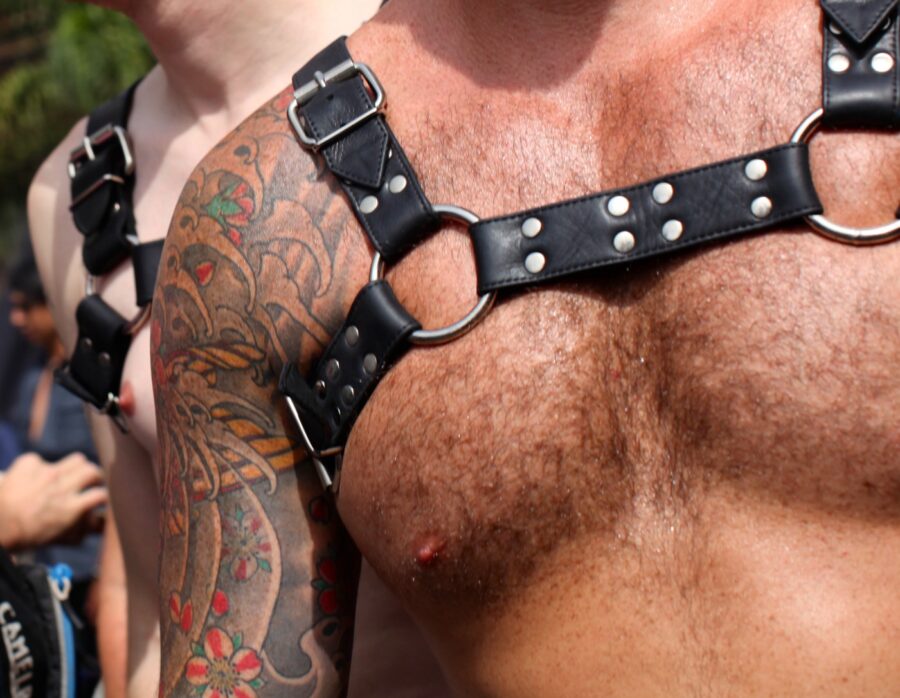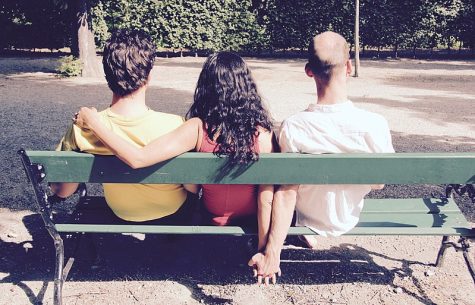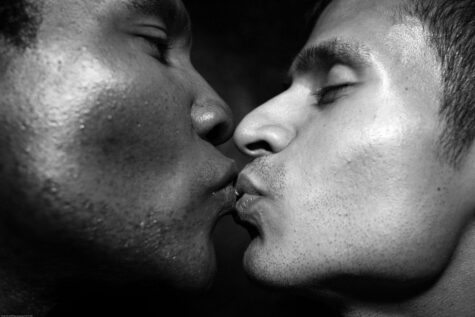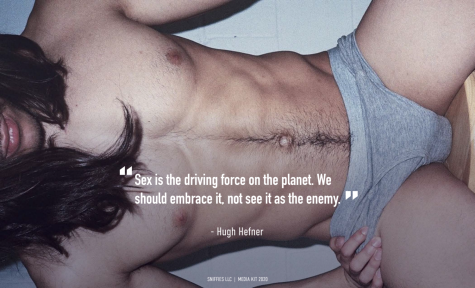Chains and Whips Excite Me
How the gay leather scene nearly died and bounced back in less than 20 years
The birth of the gay leather scene started in the late 70s, a time when queer people were coming out and celebrating their “alternate” sexuality. Across the nation parades and marches were being held to celebrate the so-called gay liberation and Harvey Milk was being celebrated as the Mayor of Castro street. So many things were happening at the time that it was easy for the gay men to build a sexual community of men who like things more “extreme.” They donned leather, metal, denim and aviator glasses, cruising each other at the baths, or piers or the back rooms of bars. They fisted and fucked and rimmed and tied each other up and pissed on and beat each other — everything was on the table in the newly born leather scene.
But while these men fucked and sucked and fisted, a silent killer was walking among them, a danger so pervasive that most everyone who went to the baths was already infected. Cursed to die in the coming years while their plight was denied by the White House, the leather scene was in full swing when AIDS reared its ugly head. Many were lost in the plague — and with them the rituals and knowledge of the community they fought to build — a community of brotherhood, trust, and sex.
Thomas Trafelet was one of the lucky ones to avoid the plague and live to pass on his experience and knowledge to younger generations of men.
Trafelet, a 62-year-old man originally from Michigan, is active and vocal in the current leather community. He was 27 when the plague struck and began killing the men in his local gay community. He was there when the first person in Chapel Hill — a person his friends knew — died of AIDS.
“I mean the only reason I am alive now is because I ended up in rural North Carolina. I was on my way out here to Los Angeles in 1978 from Michigan to go to film school and I would have been a brass plaque and a distant memory if I had succeeded in that, and I was very fortunate to get diverted for 10 years to North Carolina which was great in a lot of ways.”
Trafelet recalls being in a gay group meeting when he received the news that someone had died from AIDS. He remembers running into the bathroom and throwing up. Sex was now a game of Russian roulette that killed you slowly. However, through the help of a magazine called Drummer*, Trafelet was able to find a way to get off with out actually fucking.
“That was when sex died for me in a way, because we didn’t used to call it bare-backing back then; we just used to call it fucking. So the whole leather thing to me, being a very creative person, represented an avenue to alternative sexual expression, as I call it now.”
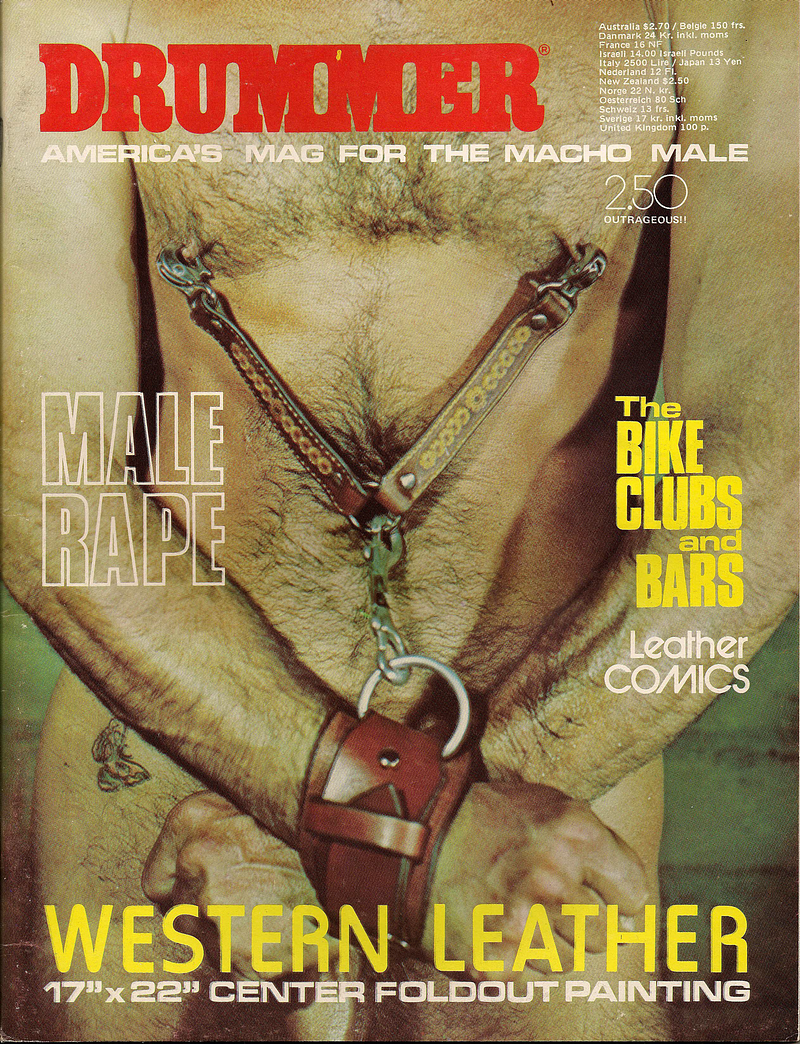
The magazine began somewhere between 1975–1976 and published over 200 issues into the 90s when the Internet exploded, killing many niche papers and magazines. The content, Trafelet said, was a sort of guidebook for those interested in BDSM. It gave how-to-guides and showed pictures of the proper knots to use when tying someone up, and helped move the community forward and through the AIDS crisis.
“I’d look at Drummer and I would see there were all kinds of ways to express your sexuality without fluid exchange and that intrigued me — the hot men, the leather. Just all these different things, these different ways to express your sexuality and that pretty much hooked me.” From that point on, Trafelet said, “You start collecting crappy toys and making stuff up” with what he now calls “pervertables.”
“You go to Home Depot and go through the hardware store and see clamps and chains and ropes and things that are for sale and go ‘Oh we can make something kinky out of that.’”
The magazine wasn’t the only outlet that was drawing the interest of men into BDSM and leather. The 1980 film Cruising, starring Al Pacino, was set within the New York leather scene of the time. In the film, Pacino’s character, Steve Burns, is a New York cop working undercover to catch a killer targeting gay men in leather bars. For its time, the film was rather edgy and put the community in the limelight — but not for the best.
A man who prefers the name “Sir River” said that as a member of the leather community during that time, he was disturbed with how the film portrayed his community.
“Well it’s hard to say if it was bad or good for us, but I remember I went to see it with a friend and we ended up screwing in the theater. But then again, so were other guys because it was a gay theater. After, my buddy turned and said to me, ‘That really made us look awful, didn’t it?’ I had to agree, it made us look like lustful beasts — which we were, but also depraved.”
According to Sir River, he had been part of the protests that took place during the shooting of the film because he thought, along with protesters, that the film would be anti-gay.
“It was the best. We got to shout and make a scene. I went in drag with a whistle that I blew anytime Pacino spoke. We really were a riot.”
The protests, which were sparked by journalist Arthur Bell who wrote the series of articles which were used as the basis for the film, drew a thousand protesters at one point. The leather community rebelled which prompted Pacino to come out in defense of the film and the community.
Still, the community was coming under fire from within as well. When gay author and screenwriter Larry Kramer published his novel, Faggots, the entirety of the community lashed out. Kramer’s opening to the novel, which has the protagonist cruising a bathhouse and being invited to fist a stranger, portrayed a sex-starved community of men.
For Kramer, this was an attempt to reconcile his own issues with the gay community — including the leather scene. And although it is still one of the most detailed accounts of a gay man’s life during that time, many gay men took it as an insult.
“People would tell you to hide it, or just burn the damn thing. I love reading, and at the time, I wanted to see what [the scene] was all about. A friend told me about Larry’s book and I read it. It was like being slapped in the face, but I couldn’t put it down. That man is a genius. Total asshole for sure, but a genius,” said Sir River.
But while New York was dealing with Kramer and Cruising, Los Angeles began to become a hotspot for leathermen and BDSM enthusiasts.
“I came out here, and by then we at least had some idea of what to do [play-wise]. I remember the first time I walked into the Gauntlet II, which is now the Eagle.”
It was April of 1988 and Trafelet was on a survey tour after coming into some money. He had planned to see Los Angeles and decide if he wanted to live here or find another part of the country to call home because he was living in rural North Carolina in a pre-Civil War 160-year-old farmhouse.
“I had a very rural bucolic life at the time,” Trafelet said.
But once he moved to Los Angeles, Trafelet went the Gauntlet having read about it — in Drummer magazine.
“I had never seen so much dead cow wrapped around so much hot beef in all my life. It helped make up my mind that all of this is where I have to be.”
After moving into an apartment in the Beachwood Canyon in the Hollywood Hills of Los Angeles, Trafelet said that he learned about Avatar, an organization revolving around BDSM.
The club was founded and has been active since January of 1983, and although it is primarily for gay men, Avatar hosts events that are open to the public, as long as you are over the age of 21.
“I went to my first Avatar Meeting in January of 1996,” said Trafelet. “By then I was already going to the bars and tricking and playing and all of that. Avatar gave me a home to really begin learning because Avatar was and still is a men’s BDSM educational and social organization which has gone through many ups and downs over the years and is now on an upswing again.”
According to Trafelet, Avatar is one of the few remaining men’s clubs that provides guidance and mentorship for men into BDSM. Over the years, Avatar built a tribe of men who provided a very specific practices and expertise to the community and to those seeking to learn.
“Avatar gets quite specific and there are a lot of people in there that have a very specific wealth of knowledge. A lot of it’s lost because a lot of these people died, which is tragic.”
Having a background in teaching, Trafelet became active in the educational side of the club and promoting the club’s ideas. He said that part of the fun was giving people the tools and experience to indulge their own desires.
“I really enjoyed and still enjoy giving people permission — giving people permission to explore their own sexuality. They have curiosity and interest and they may not know how to begin, and Avatar has provided that for countless men over the years.”
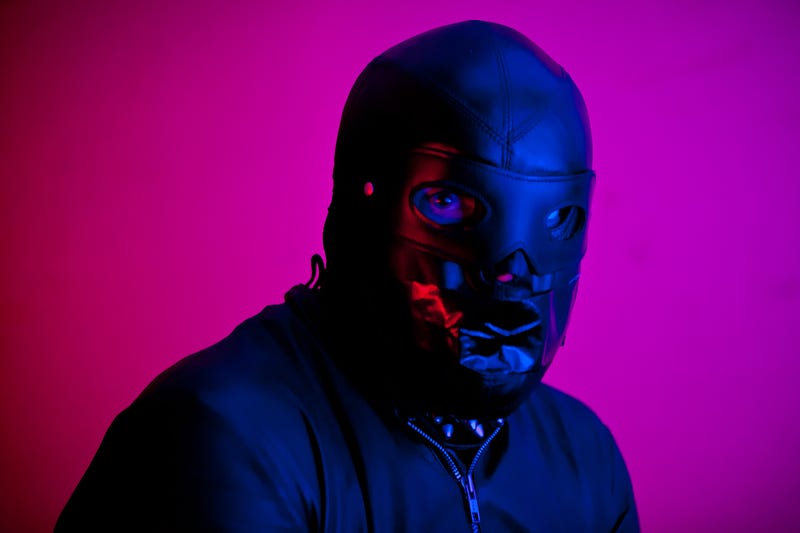
To this day, Avatar continues to be a place where not just men can go to explore a different side of their sexuality. However, there is one issue that seems to be keeping the club from progressing further — age.
Because of the longstanding history Avatar has had in the community there a mentality has developed around the group that it is only for older men. This is completely inaccurate, said Trafelet, but it is hard to get younger men interested. Part of this is the succession of leadership in the group.
“No one wants to let go of their positions of power because, and I’ve experienced this too … but if you’ve been in a club for 25 or 30 years and you’ve had this position of power, you don’t want to let it go because then you’re hit with your own mortality.”
It is this, Trafelet said, that frightens many of the older men not only in Avatar but other men’s “social clubs,” as they’re referred to. Because of this fear, the older generations have a tendency to run off younger men who are only looking for avenues to learn and explore safely.
“The young guys come in and they go ‘I just want to know’ that is the great sin that happens across the board and I would call out older people to say, ‘look, you know, are you more concerned about your ego or the succession of the organization that you’ve invested your life in.’”
One solution is to make a place for elders in the community to gather and play and explore because, as Trafelet points out, “‘Elder’ does not mean sexless.” What “elder” refers to is somebody deserving of respect, someone accomplished with a lifetime of wisdom and institutional knowledge. This experience and knowledge is crucial for younger people if they want to change course and do something different.
“At least they know where they come from,” said Trafelet. “But to be working in a void of ‘I don’t know,’ and ‘we don’t know,’ I mean people reinvent the wheel over and over again and waste an inordinate amount of time arguing over the color of napkin rings when there are such bigger visions to have.”
One such group working toward the betterment of the community are the Los Angeles Band of Brothers which emerged from the Los Angeles titleholder system in 2008. After winning a 1999 title at the Faultline, William Schindler, along with a group of other leathermen, founded the Los Angeles Leather Coalition. The LALC is a group comprised of various organizations throughout Los Angeles.
Since 2008, the LA Band of Brothers has invited titleholders from the roughly nine to 11 feeder contests to join the fraternal club. In 2010 42 titleholders came together and formally made the Band of Brothers a legitimate organization.
The group prides itself as being “a mentoring and fraternal organization whose primary mission is to help new titleholders maximize their abilities and provide fellowship for past titleholders.”
This is key in the leather community because when newbies join the scene they are often confused or unsure as to how to get involved. It is then that older men are able to share their experiences if they are so willing. At times, these curious men come and go quickly, however it is the ones that continue on that build the community and help it prosper.
This evolution has been difficult because of the gap in age left by the plague. Trafelet believes that if the older generations learned to speak to younger men, to embrace their technology and use it properly, the exchange of energy and culture can take place. It is also on the younger men to stop being focused on their phones to learn — it is a two way street.
“It is this remarkable exchange of energy, inter-generational. It is the most beautiful thing to happen, and I think we’re on the verge of that this year … personally I want to see the Band Of Brothers integrate more with Avatar. Avatar needs the youth, and the Band of Brothers are strong enough now that they can handle some of the vagaries of dealing with a bunch of [older men].”
Beyond the competitions and leather groups, there was a beautiful place for men to explore their sexuality in a primal, masculine way that has now nearly come to a halt — the Leather bar.
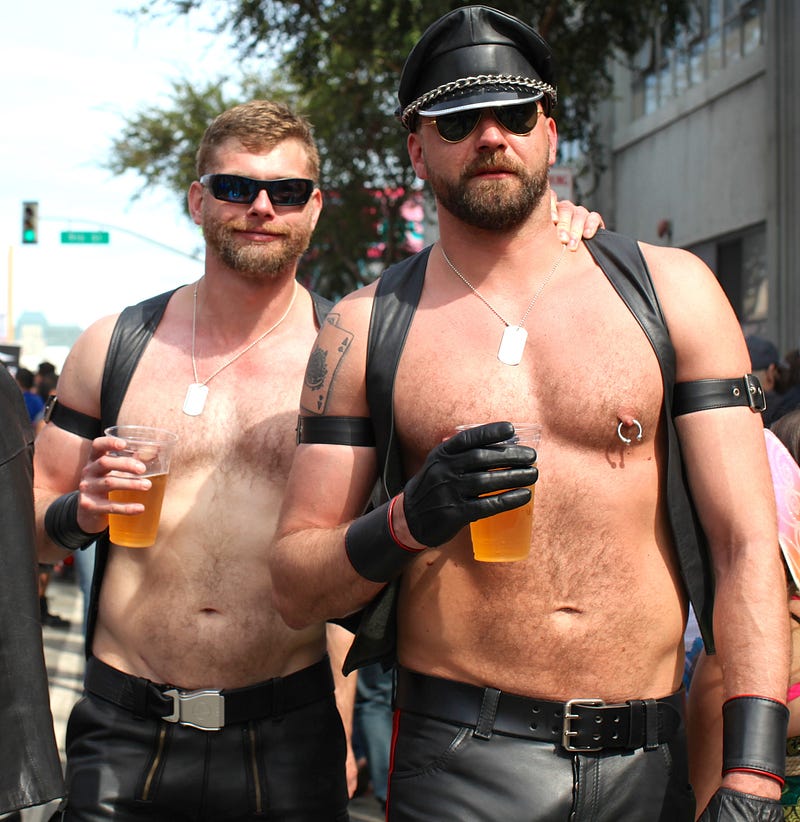
Picture a place with beer-filled plastic cups everywhere, and men shoulder to shoulder drinking and laughing. There is a neon sign of a dick on the wall that switches between flaccid, semi-hard, and fully erect while shooting neon cum. It is hard to stand steady in the sea of leather-clad men, and it’s unclear if the liquid on the floor is beer or piss, probably a mixture of both. Behind the bar is a wood fence that leads to a set of port-a-potties that reek under the unforgiving Los Angeles sun on any given Sunday in July. Men are waiting in lines to use the john, some with empty cups that are soon to be filled with piss for some thirsty leatherman.
Opposite, the wood fence continues with a portion cut out leading to a small shop called Wayne’s Leather Shop where you can buy a VHS of some really hardcore German BDSM porn. Across the bar there is a small huddle of men, looking around to keep the two guys who are fucking hidden from the bartender. The only music is the combined laughter, chatter, and moans of the many leather and denim-clad men there in a space built for queer men to meet, drink, and play.
That sight is what you would see if you went to the Sunday beer-bust at the Faultline Bar in East Los Angeles, a staple of the leather community not more than 12 years ago.
Now, the many men crammed into the small space, the cruising in the bathrooms, Wayne’s Leather Shop, and the small huddles have been replaced with go-go boys, a house DJ spinning EDM and top 40, and people taking selfies wearing shorts and v-neck shirts; the Leathermen are still there in small numbers, but the excitement of open sexuality once found inside is gone.
Thomas Trafelet was one of the many men who crammed into the Faultine for their famous Sunday beer-bust. According to him, the bar has changed drastically since the 90s.
“I used to hang out at the Faultline in the 90s. We had more bars of course, but Sunday afternoon beer-bust at the Faultline in the 90s, you wouldn’t dare show up there unless you were head to toe leather, absolutely everyone.”
This is because the bars catered to and were built by guys into the scene; men looking to be in an all-male space to be queer men. And more importantly, to be queer men without any women.
“There were no Hawaiian shirts, no flip-flops and no women. At all. There were no women at all, this was a male space … the only woman I remember was the chicken lady.”
Back in the day, the Faultline used to serve food. According to Trafelet, there used to be a “big African-American woman” who would cook fried chicken and bar food.
“[There was] this big tall woman, big loud broad, she was great, in ripped fishnets, and she’d come out there and go,
‘CHIIIIIIIIIIIIICKEN! CHIK-CHIK-CHIK-CHIIIIIIIIICKEN! SUCK-SUCK-SUCK-SUCK-SUCK-SUCCULENT CHIIIIIIIICKEN!’
“And she was great, so that was the only woman that was out there.”
Patrons would pay five dollars and scarf down their food while drinking pitchers of beer. It was a much wilder place back than than it is now.
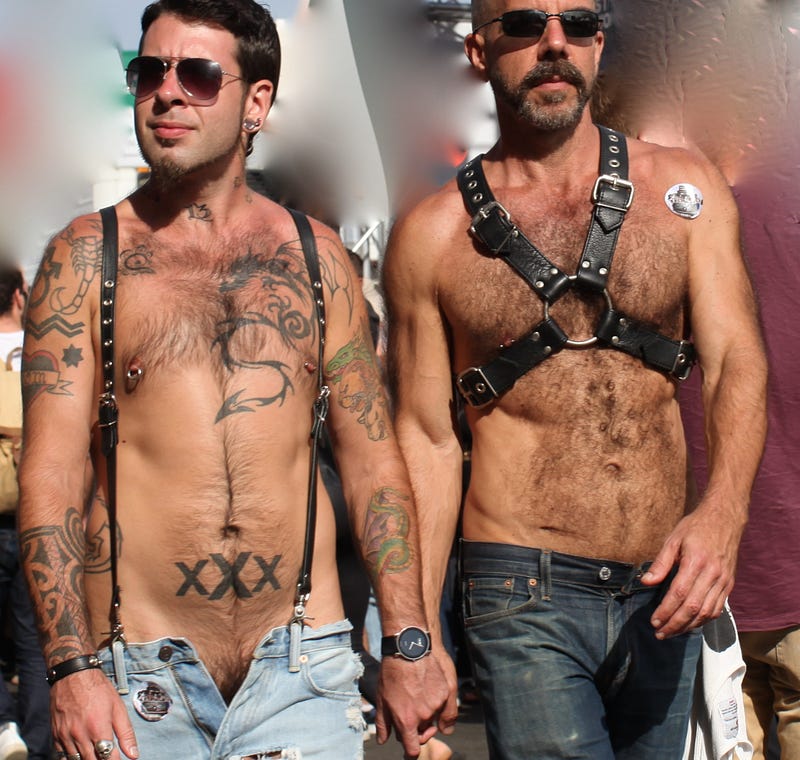
But kinky men looking for the old Faultline will be hard-pressed to find anything with any resemblance to the bar. In the past 10 years, the bar has undergone a slew of remodels and owners. The current owner, Ruby De Fresno, has been unavailable for comment since taking ownership. However, she is responsible for the current state of things, including some of the more fetish-kink nights.
Still, the bar has been around for ages, albeit under different names. Prior to its current iteration, the bar was incorporated and called the Stud until it than became Griffs. Although the name has changed, it is still licensed under The Stud.
Whatever the name, the fun side of the leather bar remained for quite some time before evolving into what it is now. There used to be a wooden fence along the back with a giant bar cooler where there is now a DJ. On the same side of the patio there was a balcony where you could get a better view of the sexy, sweaty men. Back there in the corner there was a hole in the fence and they had porta-potties where a lot of the fun would take place.
“You’d go out there and smoke dope, drink piss, and you know, carry on. Get some blowjobs, whatever you could get away with, particularly on a really busy Sunday when it was just packed.”
In the time that Trafelet was cruising the Faultline, there were other bars with a darker, more anonymous atmosphere. These were the places that would get shut down by police and city commissioners, where piss was the drink of choice and sex was never on the table — it was in dark corners.
Near where Hyperion and Fountain meet, up a hill into Griffith Park Blvd. sits a dumpy little gray building with a big flat mansard roof on the front, and a barber pole outside. That is where some of the best times were held for the leather community.
“Cuffs was the best, it was the sleaziest little beer bar … they got shut down so often, it was great,” said Trafelet. He described Cuffs as pitch black to the point that people would get blinded when they walked in from the daylight.
“Afternoons were great, oh my God you could go down there and get a blowjob in the afternoon at the bar and just drink beer. The bathrooms were so raunchy that they took the toilet seats off and cut the bottoms of the doors off so people couldn’t go fuck in the bathrooms.”
Trafelet said that it was a square bar that took most of the area. This allowed for people who had their dicks out to just put them away when someone came in, not in shame, but because it was never certain if it were a man dressed as a cop or an actual Vice officer.
During an election cycle the bar saw more lewd conduct arrests to make it seem as if the police were doing their jobs and earning the revenue from taxes.
“Every election cycle you’d get more lewd conduct arrest because the fucking cops would come around there just to show off — ‘Oh this is how we earn our money, bust the faggots’ and all that crap.”
However, that did not stop the community. If you were discreet and smart, you could get away with almost anything.
“I remember one night in Cuffs in summer, and it was just packed way beyond capacity. There was one guy that was just walking around just totally naked, just took all of his clothes off, and I just look and him and was like ‘yeah dude’ and he goes ‘well somebody’s gotta do it.’”
People would go on afternoons for the beer and come back during after-hours for Euro/Techno music which was still new and only at Cuffs. People would go up on a little balcony and huddle, so that if someone was giving another guy a blowjob he couldn’t be seen. That was the only rule.
“Don’t make the bartender have to tell you to put your dick back into your pants, that’s indiscreet. The things you did you did discreetly in the corner, because the bartenders didn’t really care, but they had a liquor license,” said Trafelet. Eventually the bar had a lot of trouble with their liquor license. Among other problems, this led the loss of all-male spaces, a factor in the decline of the leather community.
Time has not been totally cruel to the leathermen and their ilk. Because of the work of men like Trafelet, there was a major push recently to archive the leather history. The One Archive Foundation at USC Library houses the largest collection of queer photos, papers, books, and articles in the nation, perhaps even the world.
Jay Lawton was one of the primary and active documentarians for the leather community over the last two decades. His work donated to the One Archive include some work for the Tom of Finland Foundation, Mr. Los Angeles Leather, and numerous events and bars. His documentation provides a look at what men used to do and they brotherhood built by queer men trying to be queer men. However, what his photos cannot and did not capture are the experience one gains from in-person interaction.
“You can read things, you can look at things online, you can get to a certain point I think and even with the amount of books that are out today, probably begin to learn,” said Trafelet.
But in his eyes, it is just better when you learn from someone with experience who watch everything you do and passing on their knowledge.
“I teach people how to flog and I have a pretty standard curriculum that I have with teaching them how to use their bodies and aim and all that and be consistent and that’s my style. I’d like to see a lot more teaching, it’s really my dream.”
*This is a link to some issues uploaded on scribd.com and not an official site.

